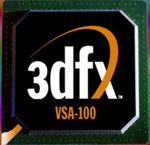Luckily for all PCI card shoppers out there, the Voodoo5 5500 PCI is identical to its AGP counterpart with exception to the interface. A few weeks ago we took a very extensive look at the retail version of the 5500, a review which may be found here. In an effort to recap some of what the Voodoo5 5500 is made of, below are a few sections that summarize our results.
 VSA-100
VSA-100
Each VSA-100 chip is based on a an "enhanced" .25 micron architecture with 15 million transistors on each chip. The SLI linking is a bit different than the older multicard SLI solutions offered by 3dfx in the past. The Voodoo5 5500 links its two processors using a 30-bit digital interface between the chips, providing for faster transfers and less degradation than found in the previous analog SLI solution. The chip adds support for 32-bit rendering, 32-bit textures, a 32/24-bit Z&W, and an 9-bit stencil buffer, providing for many improvements over the Voodoo3 chip. Each chip is able to process two pixels per clock.
The Card
Looking almost identical to the Voodoo5 5500 AGP, even the layout and design of the cards are nearly identical. The card features two of the VSA-100 chips, linked together in the previously mentioned SLI fashion. Physically the card has 64MB of memory, however all this memory is not available for each processor since textures must be duplicated for each of the 32MB of memory dedicated to each VSA-100 chip. The shared frame buffer memory means that the Voodoo5 5500 effectively has more than 32MB of memory to work with, but less than 64MB. The memory on our sample card was MT SDR 6ns memory, very similar to the Toshiba memory found on our sample AGP 5500. The two VSA-100 chips provide the 5500 with a fill rate of 667 megapixels per second in signal textured games and 333 megapixels per second in dual textured games. The fan, heatsink, and power connector remain unchanged.
AGP?
Perhaps one of the most interesting aspects of the Voodoo5 5500 AGP is, well, its lack of AGP. Take a look what we said in our Voodoo5 5500 review.
The chip is an AGP 4X part, with support for AGP 2X, AGP 1X and PCI operating modes. In spite of this the VSA-100 does not support AGP texturing. 3dfx still feels that AGP texturing is not truly beneficial and thus there is no reason to pursue support for it with their products.
What does this mean? Essentially it means that the Voodoo5 5500 AGP really is not a true AGP card after all. Sure, it operates at 66 MHz, but it does not take advantage of the biggest AGP feature: AGP texturing. Without the AGP texturing, running the Voodoo5 5500 in an AGP slot is like running it in an overclocked PCI slot, as the only difference is the speed at which information travels to and from the card, 33 MHz for the PCI version and 66 MHz for the AGP version. This means that the card is basically running in a 66 MHz PCI slot when in an AGP slot. In a bit we will take a look at the benchmarks and see how much of a difference this 33 MHz makes in game play.
FSAA
Both our Voodoo5 5500 review and our FSAA & Image Quality Comparison took a look at the FSAA quality of the Voodoo5 5500. To recap, here is a section from our FSAA & Image Quality Comparison.
3dfx definitely has the best 2 sample FSAA setting out of the bunch, although we were unsuccessful with tweaking the LOD bias settings when enabling 2 sample FSAA (other artifacts would pop up), the setting still seems to offer the best overall result in terms of image quality and performance.
The VSA-100's T-buffer seems to do the trick when it comes to FSAA, not only making the PCI Voodoo5 5500 the first PCI card to support FSAA but also one of the better AGP ones when it comes to support of it.










0 Comments
View All Comments